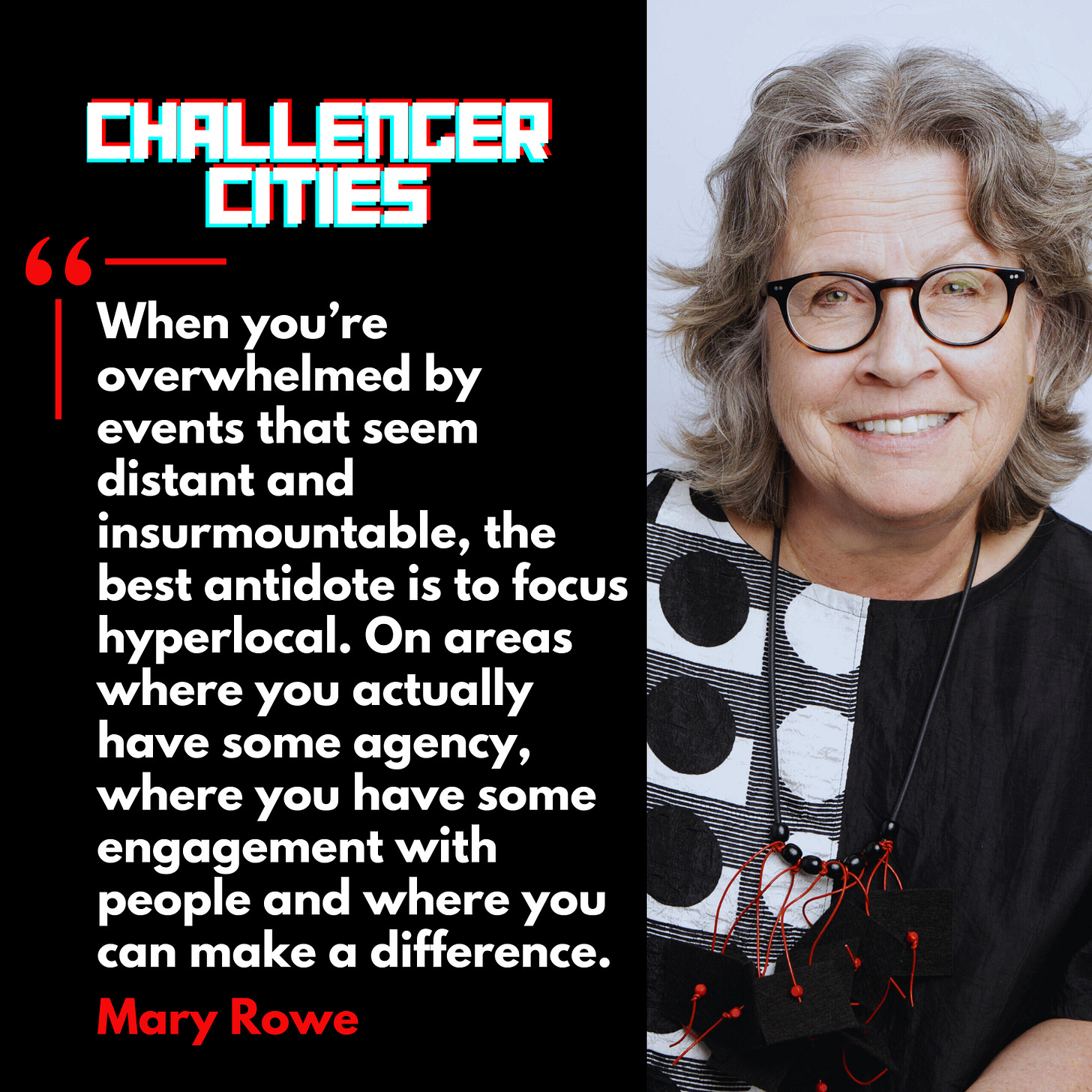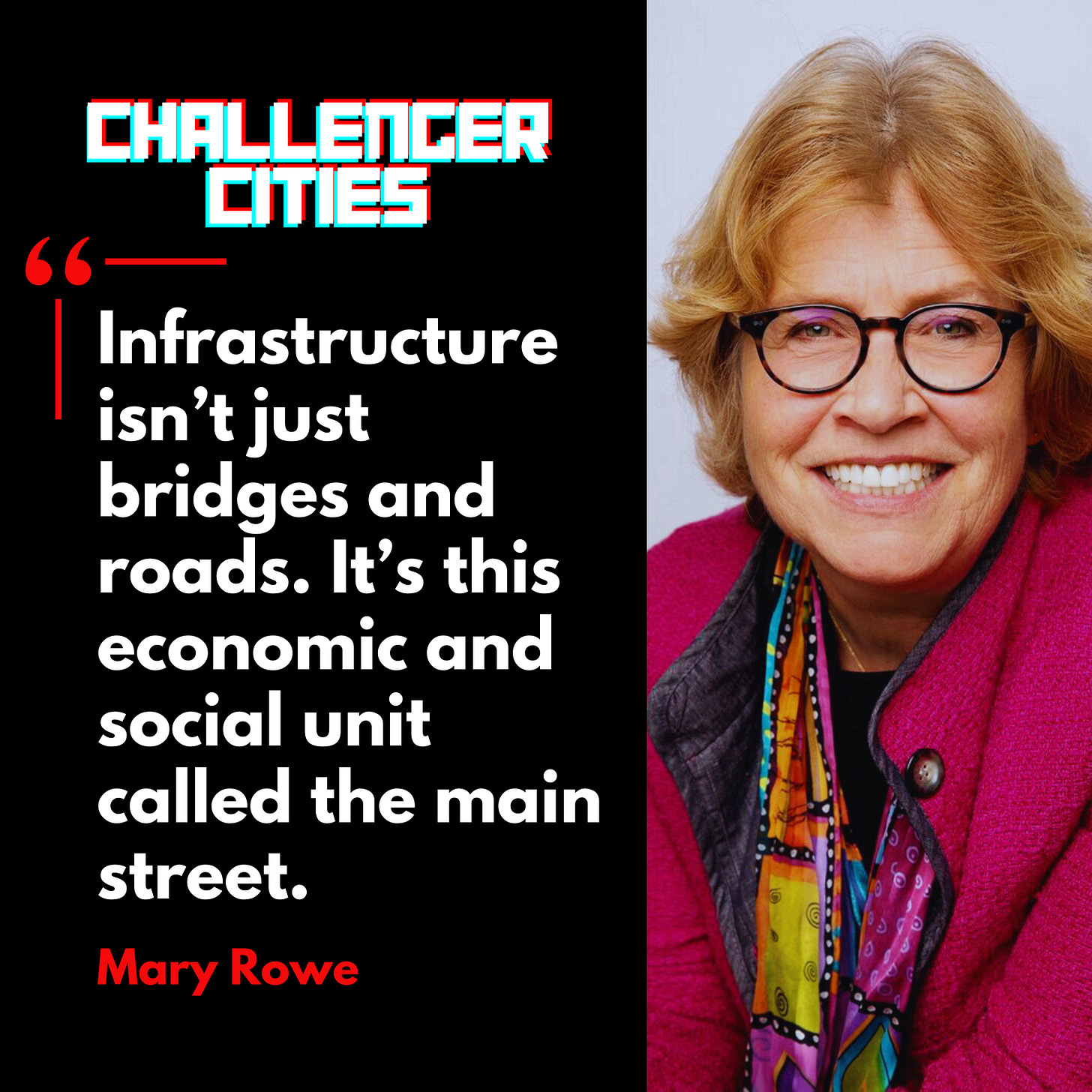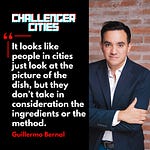When Mary Rowe speaks, you listen. Not because she’s loud (well maybe a bit) or because she’s fiery (though she sure can be!), but because she has this remarkable knack for making the small, local and seemingly insignificant feel revolutionary. As head of the Canadian Urban Institute, Mary’s take on cities is refreshingly pragmatic, tinged with optimism, and deeply rooted in the belief that change starts at street level. Now that’s a bit of a Challenger mindset!
Our conversation touched on everything from pilots and main streets to the magic of mutual aid. But above all, Mary reinforced that if cities are going to be better, they don’t need lots of big fixes … they need continuously bold experiments. Cities aren’t about perfection, they’re about momentum. That starts locally.
Why Localism Matters
For Mary, the antidote to what can feel like globally overwhelming events lies in focusing on what’s close to home. She explains, “When you’re overwhelmed by events that seem distant and insurmountable, the best antidote to that is to focus hyper-local—on the areas where you actually have some agency, where you have some engagement with people, and where you can make a difference.”
This perspective stems from her deep belief in the power of local agency. By tuning into the immediate needs of neighbourhoods and main streets, she argues, we can create tangible improvements that ripple outward. “When it really comes down to it, what matters is how we relate to our neighbors and ensuring that we have the kind of conditions so that we can make the lives we want to make for each other and for ourselves.”
Hyperlocalism, as Mary describes it, is not just a practical strategy—it’s a deeply human one. In times of uncertainty, she sees it as a way to stay grounded, connect with others, and rediscover the joy of incremental progress.
The Importance of Pilots
Mary’s approach to urban innovation is rooted in small-scale experimentation. Pilots, she says, are the key to overcoming fear and inertia. “The principle of a pilot is to de-risk it. You try something in a smaller geography so it doesn’t affect hundreds of thousands of people—it affects a few thousand. And then you can adjust.”
Toronto’s King Street Transit Pilot stands out to her as a rare success in this approach. “The fact it happened at all is a miracle,” she says. The project, which gave streetcars priority over cars, demonstrated how testing bold ideas can pave the way for larger shifts. But Mary is quick to note that pilots are only as good as the momentum they create. “It’s not about solving the whole problem at once. It’s about getting people to see that change is possible.”
Now, this is where perhaps we need to do more with the pilots once they’ve proven our point. What do we pilot next? And how do we scale the lessons we’ve learned from the pilot experience? This is where local takes us so far, but then we must build on the successes so we’re not discouraging people from seeing the change that can be started on the local level.
The other key point is how pilots also allow for flexibility, which Mary points out as essential in a country as diverse as Canada. “You can’t have the same rules for rural Newfoundland as you do for downtown Winnipeg,” she explains. “Pilots let you test solutions in a way that’s tailored to local realities.”
Main Streets as Infrastructure
Mary’s passion for main streets is for they are not just nostalgic relics of a simpler time before big box stores and car culture, they’re critical infrastructure for the future of cities. “We’re making the case that main streets are infrastructure,” she says. “Infrastructure isn’t just bridges and roads. It’s this economic and social unit called the main street.”
Main Streets are where communities come together, economies flourish and cultures thrive. But she also sees untapped potential in these spaces. “There are ways to ensure that you get more housing choice along main streets. We ran the numbers and think you could get three and a half million housing units if you intensified existing main streets. It’s good for climate, good for the economy, and good for all sorts of reasons.”
Mary’s vision for main streets includes a reimagining of how they function. “What if bookstores shared space with medical clinics? What if retail spaces hosted multiple vendors? We need to create more choice, more opportunity, and more vibrancy along these corridors.”
“Every community in the country can tell you where their main street is, and it may be a four corners. It may be a very long strip. It may be iconic. But even small communities do, and it might be the back of a strip mall. That level of granular analysis is important to us, and we’ve worked in partnership with a bunch of different folks to highlight that.”
While some urbanist types might consider it blasphemous, the point about third places and community hubs not having to fit the traditional image of a picturesque main street is really important. These places can exist in less bucolic forms, like the back of a strip mall, yet still play a vital role in fostering social and economic connections within a community. We must be careful to not lose these in the world of cliched urbanism tropes.
We talk about a vision for public spaces challenging conventional notions of parks and plazas as passive, single use areas. Mary imagines them as vibrant hubs of activity, brimming with commercial, cultural and social opportunity. For her, a great public space isn’t just about aesthetics but synergy.
“I’m fascinated with how we use space for commercial opportunity,” Mary explains. “A public space shouldn’t just be a beautiful park. It should also be a market, a place for vending, a space for living, and a hub for cultural and social engagement.”
This philosophy comes from observing the untapped potential of underused or overlooked spaces. Whether it’s transforming old industrial sites into markets or reimagining strip malls as dynamic community hubs, Mary sees these spaces as ripe for innovation. This means creating places where people can connect, collaborate and transact in ways that feel organic and meaningful.
“The best public spaces create synergy—where there’s a transaction, a conversation, and a sense of place all happening at once …. it’s not rocket science. People like this stuff!”
Canada’s Urban Challenges
In our conversation, Mary doesn’t shy away from critiquing Canada’s urban culture where we could be doing more. One of her sharpest observations is about the country’s tendency toward conservatism and its reluctance to embrace change. “There’s just a fascination with complaining… and I think some of this is a function of people not living anywhere else and being pretty provincial in their view. If you lived anywhere else, you’d see Toronto’s pretty darn good.”
She also highlights Canada’s unique challenges as a highly urbanized yet geographically vast country. “You’re dealing with the same kinds of problems as American cities but with a tenth of the population to solve them. It’s incredibly demanding.”
Despite these hurdles, Mary sees immense potential. She points to cities like Montreal, which turned a economic shocks through the 1970s well into the 1990s into an opportunity to cultivate a resilient local economy. “Constraints can incentivise remarkable innovation,” she says. “That’s what Montreal did, and it’s what other cities need to learn.”
Having been here for a couple of months now, it’s clear how Montreal has developed a resilient local economy that does add something to the quality of life, and small business culture which is missing in Toronto where (inter)national brands and chains can sometimes feel overwhelming.
Resilience and Mutual Aid
Mary’s faith in the power of community-led solutions is unwavering. She believes that resilience does not come from top down mandates but from the ingenuity of local actors. “I’d love to see us rekindle that kind of resourcefulness in a decentralized way because that’s how innovation happens. That’s how smart ideas get incubated. When a couple of smartypants sit around a kitchen table and say, ‘Why don’t we try it this way?’”
However, she’s also deeply concerned about the decline of institutions that once supported mutual aid, like churches and co-ops. “We have a long history in Canada of mutual aid, but the institutions that have supported it are closing. We need to double down on community centres, libraries, and other third places. That’s where the fabric of civic life is reinforced.”
This is not just a matter of nostalgia but a call to action. She sees these spaces as essential for fostering the kind of collaboration and innovation that cities desperately need.
Belief in the Imperfect
Mary Rowe’s ideas challenge us to rethink what cities can be. They remind us that progress isn’t about grand plans or perfect solutions, but it’s about small, deliberate actions that build momentum over time. Whether it’s piloting a new way of managing transit priority, reimagining main streets or fostering mutual aid, the message is clear: change starts local.
If you’re ready to make your city a better place, take a page from Mary’s book. Start small, experiment boldly and remember that even the tiniest steps can lead to remarkable transformations!
To being Challengers.
















Share this post